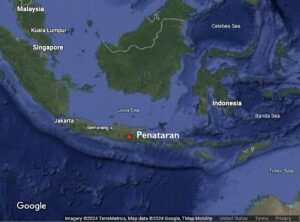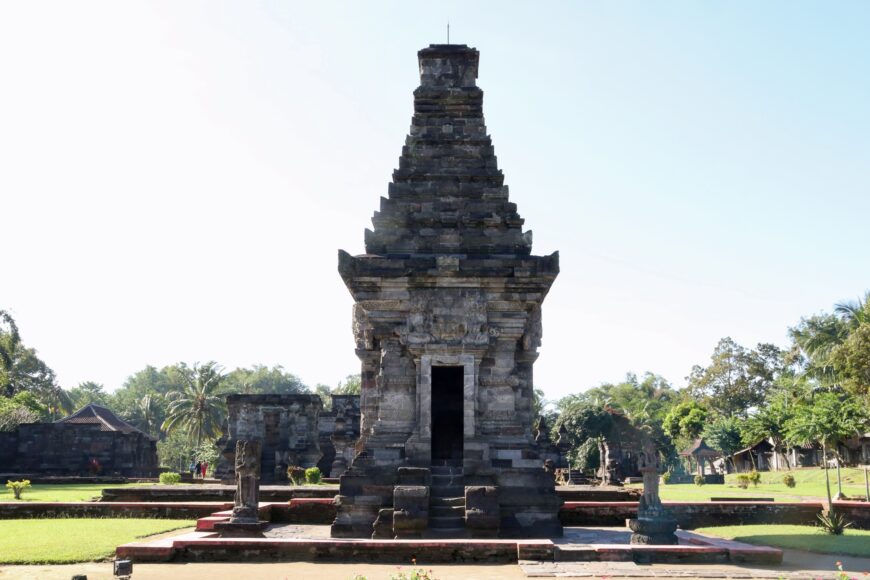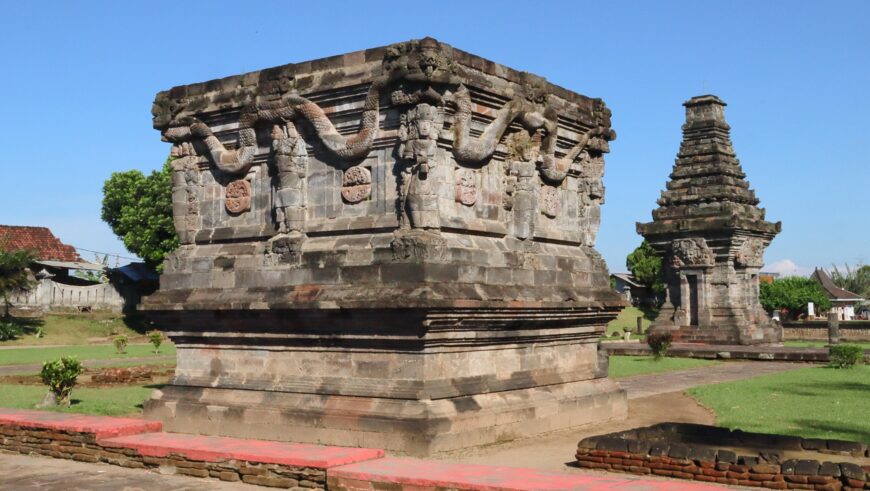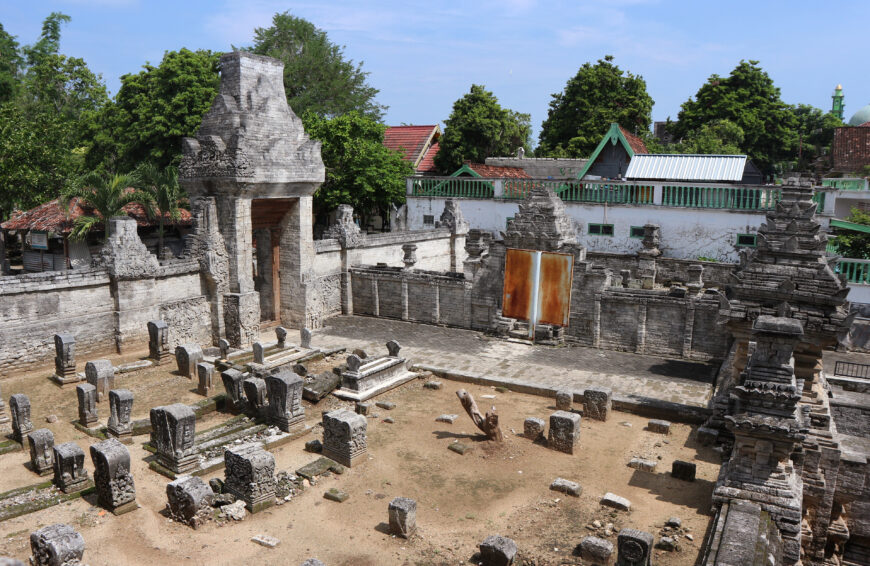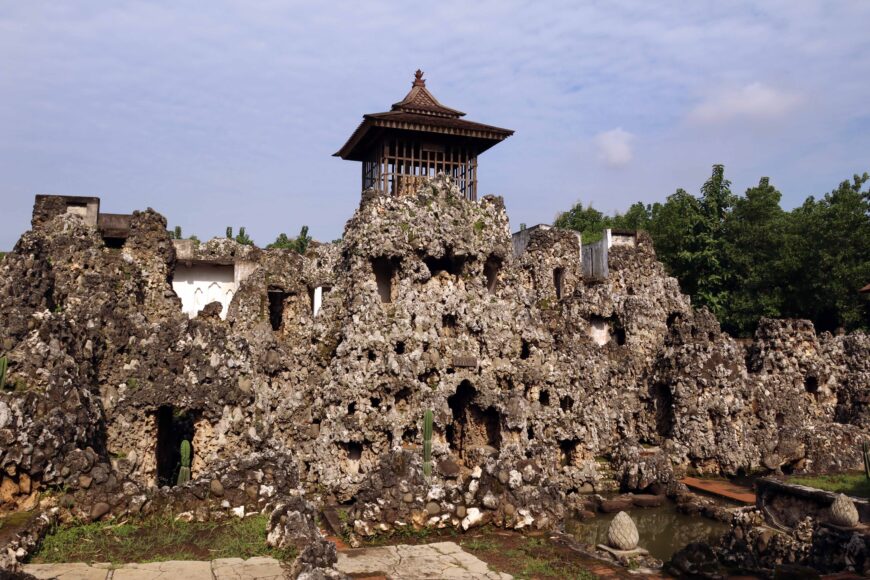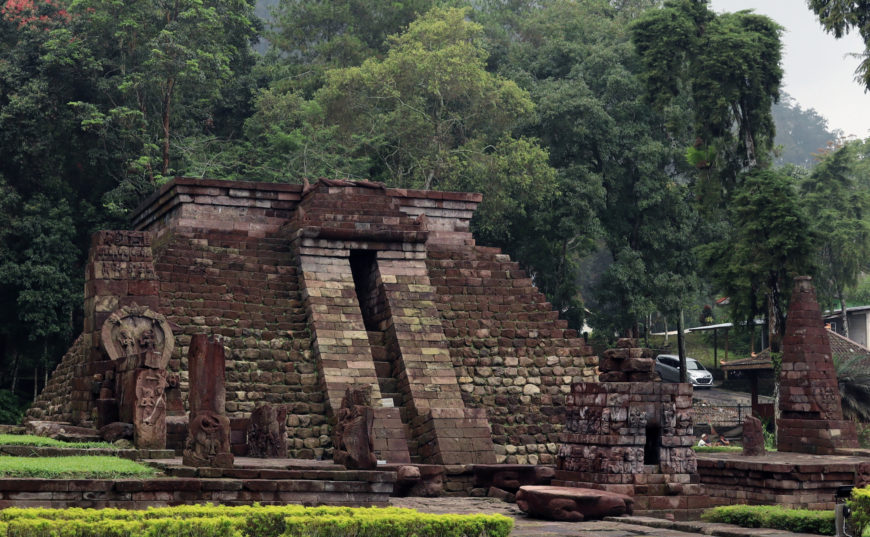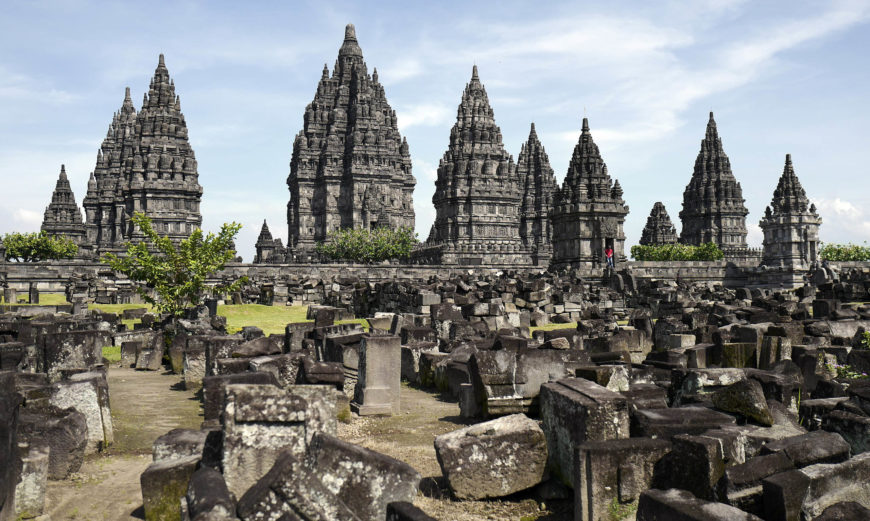
A guardian statue holding a club in the second courtyard of Penataran, with the main temple, located in the main courtyard, seen in the background, 12th–15th centuries, Java (photo: Panggah Ardiyansyah, CC BY-NC-SA 4.0)
Two enormous guardian figures with fierce eyes, fanged teeth, and clubs crouch, ready to pounce on would-be trespassers at the entrance of the temple complex of Penataran. As if the stone sculptures were not intimidating enough, a 12th-century inscription at the complex written in Old Javanese explains that misfortune will befall those who dare to disturb or damage the site.
Penataran may not be the most well-known Javanese temple in Indonesia today, but for nearly three hundred years (from the late 12th to the mid-15th century) rulers considered it their most revered religious complex. Numerical inscriptions confirm that the complex had been renovated and that new structures were added during this unusually prolonged period of royal patronage.
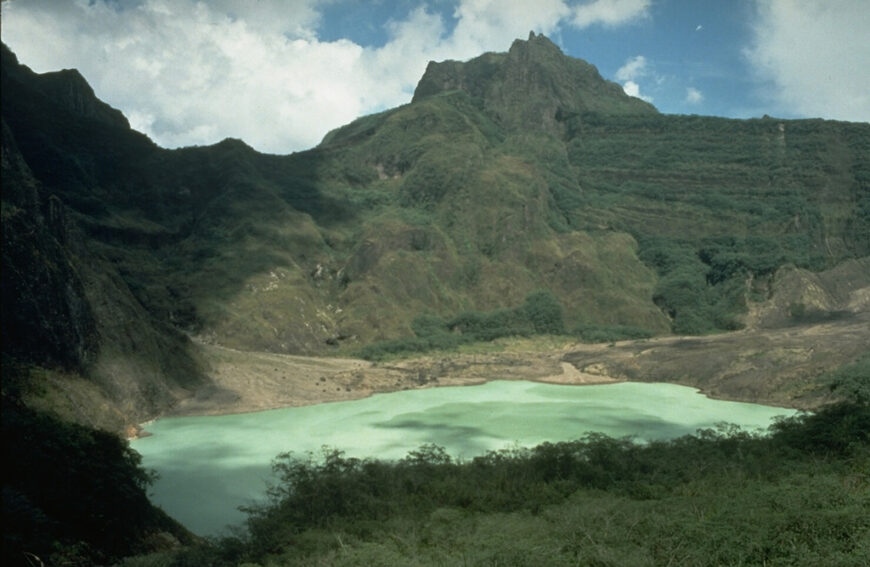
The broad, irregular summit of Kelud volcano contains several lava domes and a crater lake that has been the source of frequent violent and sometimes devastating eruptions. Mount Kelud, Java (photo: Dan Dzurisin, 1980, U.S. Geological Survey, public domain)
The Penataran temple complex is located on the southwestern slope of Mount Kelud in the eastern part of the island of Java. Kelud is considered a sacred mountain, and the construction of Penataran on Mount Kelud ensures that the temple is a part of this sacred geography.
Many of the monuments that made up the temple complex no longer survive; however, a number of shrines and temple foundations at Penataran remain, making it one of the most well-preserved religious complexes in East Java.
Originally, Penataran was comprised of three ascending courtyards, each with an entry on the western side. The main courtyard is to the east, closest to Mount Kelud, making it the most sacred space at the complex. Devotees would have worshipped in the direction of Kelud. This spatial arrangement became the archetype for later Hindu temples in Java, including Sukuh.
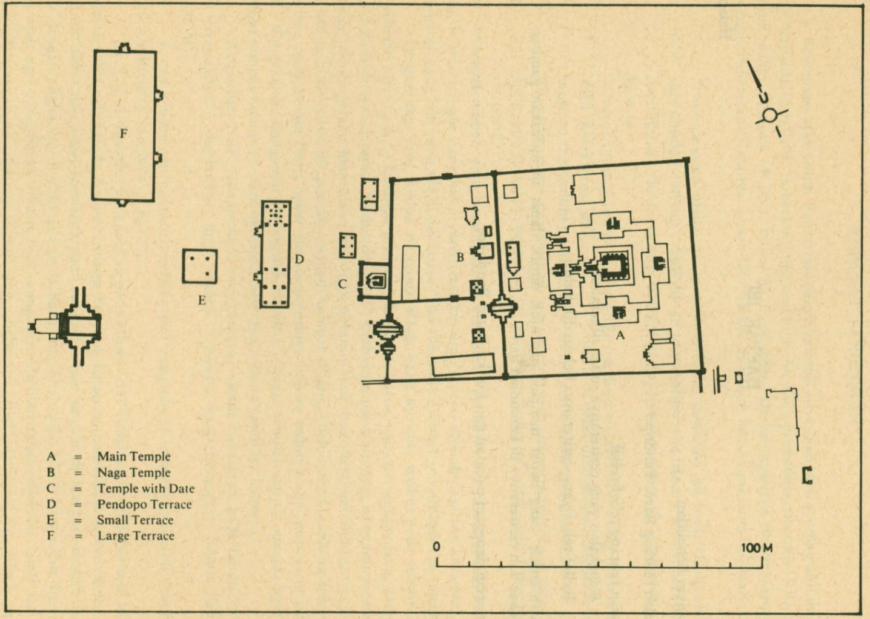
Ground plan of Penataran complex (taken from Suleiman, 1981); the first, westernmost courtyard, on the left contains C, D, E, and F; second courtyard, in the middle, comprises B; third courtyard, on the right, consists of A
An 1197 inscription at Penataran located in the main courtyard indicates that it was produced during the Kadiri Kingdom. After this time, there is a gap in construction at Penataran until the early 14th century when kings of Majapahit such as King Jayanegara (who ruled from 1309–28) commissioned structures and statues for the second courtyard, including a guardian statue dated 1320 as well as a Naga sculpture. In 1357, Jayanegara’s daughter and successor, Queen Tribuwanna Tunggadewi (who ruled from 1328–50), presented two pairs of guardian statues to the complex that were placed in front of the main temple’s double stairways. All of these have survived until today.
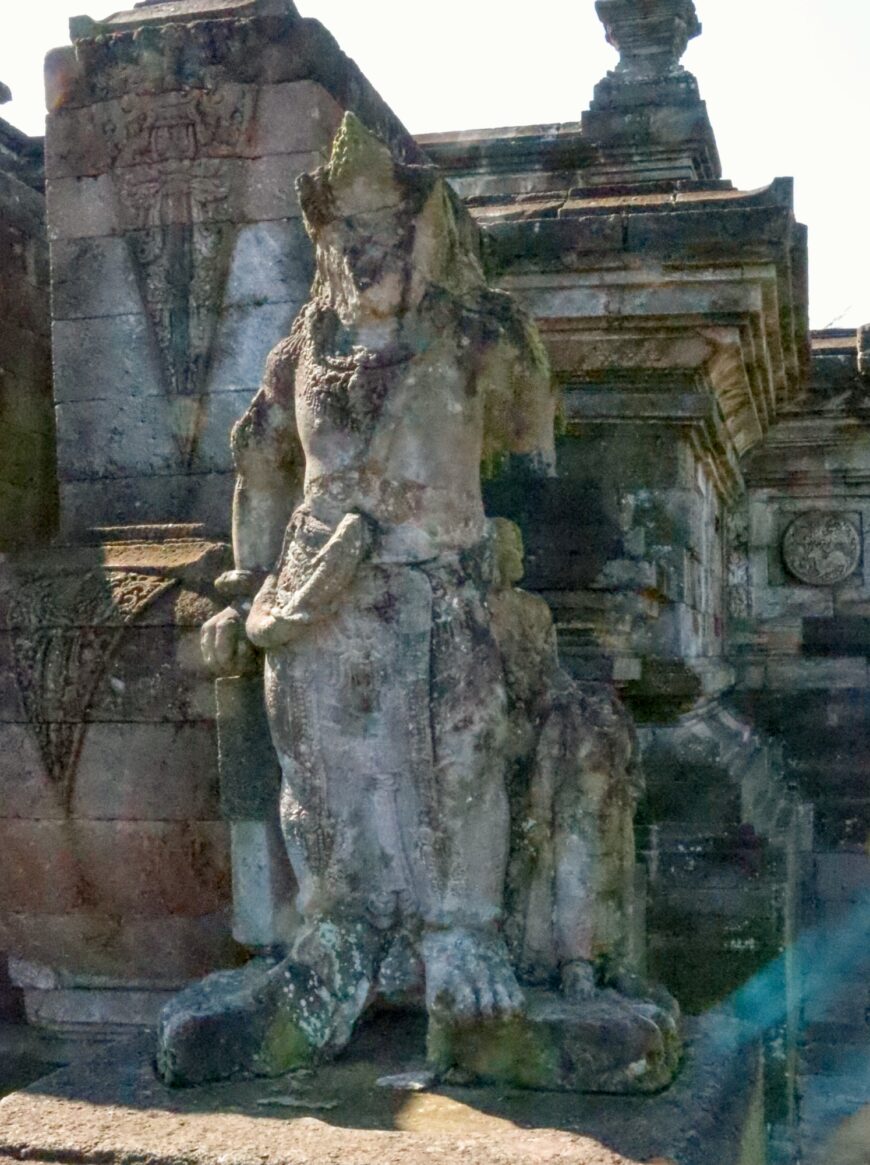
One of the guardian statues presented by Queen Tribuwanna Tunggadewi in 1347 at Penataran, Java (photo: Panggah Ardiyansyah, CC BY-NC-SA 4.0)
These additions were followed by projects sponsored by King Hayam Wuruk (who ruled from 1351–89), often remembered as the greatest ruler of Majapahit. His contributions include a temple built in 1369 (figure C on the ground plan) and a pendopo in 1375. The last dated addition to the complex is a bathing pool contributed by King Wikramawardhana (who ruled from 1389–1429). It is located behind the main courtyard and inscribed with the date 1415. The Majapahit began to gradually lose power over the next century.
Literary sources, dating from the 14th and 15th centuries, provide some insight into Penataran’s use, suggesting that Penataran was a site of royal patronage because of its religious potency and because it served as a center for religious learning. In both of these textual sources, the temple complex is called Palah; a name also mentioned in the 1197 inscription, which links the temple of Penataran to Lord Bharata Palah and Mount Kelud.
In the 14th-century Old Javanese manuscript, Desavarnana, we are told that Hayam Wuruk, a powerful ruler of the Majapahit empire, visited Palah on his pilgrimage across the territory. It is said that he was hoping for a blessing for prosperity from god Acalapati at Palah. Acalapati in the Old Javanese language refers to the “lord of the mountain.” It is widely accepted in the region that the name Acalapati is a local variant in ancient Java for the Hindu god Shiva.
Bujangga Manik, a 15th-century Sundanese manuscript, uses the term “Rabut Palah” to describe Penataran as both a center of devotion and an admired place for learning. “Rabut” means venerated or sacred. Linguistically, rabut can also mean a hill, thereby underlining the interrelation between sacrality and mountainous landscapes in Javanese cultures.
Architectural layout: the first courtyard
The first courtyard is narrow and is essentially an elevated platform where the Pendopo Terrace (figure D on the ground plan of Penataran complex) is situated. Today this terrace (which once had a roof) consists of a stone platform atop an earthen foundation, inscribed with the date of 1375. Narrative reliefs are carved into the stone walls of the platform that depict stories taken from kidung poetry (an Old Javanese poetic genre that largely dates from the 14th and 15th centuries).
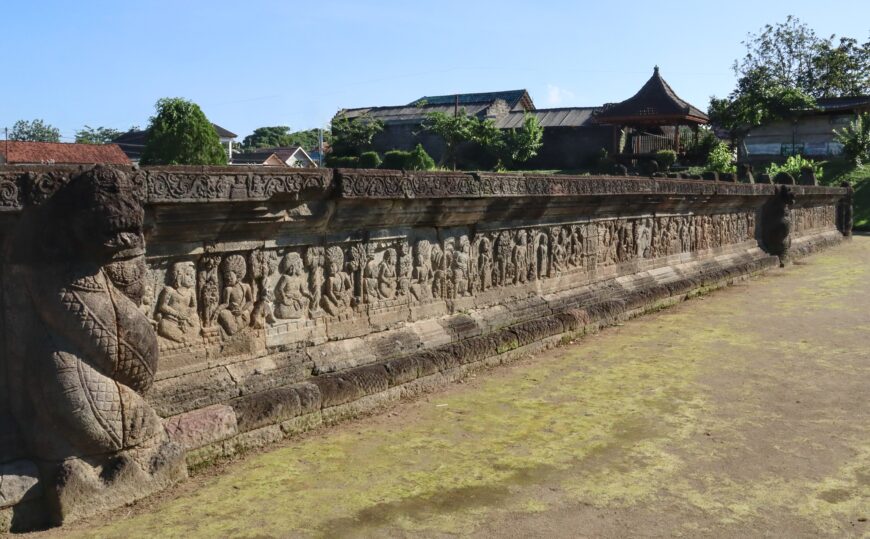
The relief panels on the eastern wall of Pendopo Terrace at Penataran, 14th century, Java (photo: Panggah Ardiyansyah, CC BY-NC-SA 4.0)
Three different kidung stories are identified in the Pendopo Terrace: Bubuksha, Sri Tanjung, and Sang Setyawan.
Bubuksha narrates a story of two brothers, Bubuksha and Gagang Aking, who meet a hungry tiger. While Gagang Aking refuses to sacrifice himself, Bubuksha unselfishly offers his body to be eaten by the tiger. It turns out the tiger was in fact Bathara Guru, the supreme god, in disguise.
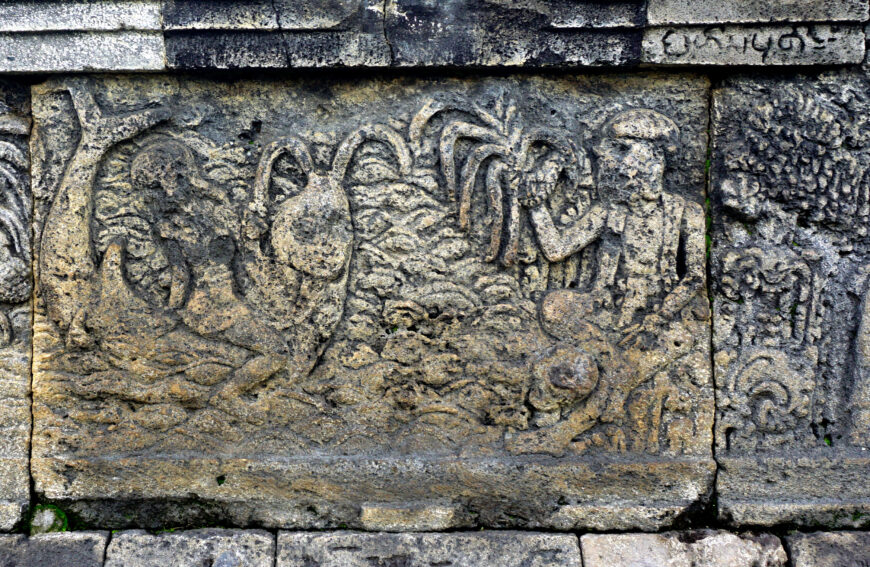
One of the panel reliefs in the Pendopo Terrace, showing Sri Tanjung, on the left side, entering another realm as symbolized by her riding a fish, and being watched forlornly by her husband, Sidapaksa, on the right, Penataran, 14th century, Java (photo: Anandajoti Bhikkhu, CC BY 2.0)
Sri Tanjung is a story of love and separation between Sidapaksa and his wife, Sri Tanjung, who is being courted by King Sulakrama. Despite the king’s efforts, the couple manages to stay together until the end.
Sang Satyawan is another story of love’s power. In this story, the Suwistri had to survive a series of life-threatening challenges in order to be with Sang Satyawan, an ascetic who was destined to be her husband.
All three visual narratives are intended to be circumambulated in a counter-clockwise direction around the Pendopo Terrace. While we have no written source on its function, this terrace was likely used as a repository for ritual offerings. Meanwhile, the presentation of kidung-based relief speaks to the popularity of such local stories during the period of the Majapahit empire.
Another structure within the first courtyard of Penataran is a temple nicknamed the “Temple with Date” (figure C on the ground plan) because of the inscribed date of 1369 found on the lintel. The temple appears as a tower that has a single chamber, accessible through a door on the west side. Above the door is the head of Kala, the guardian of time.
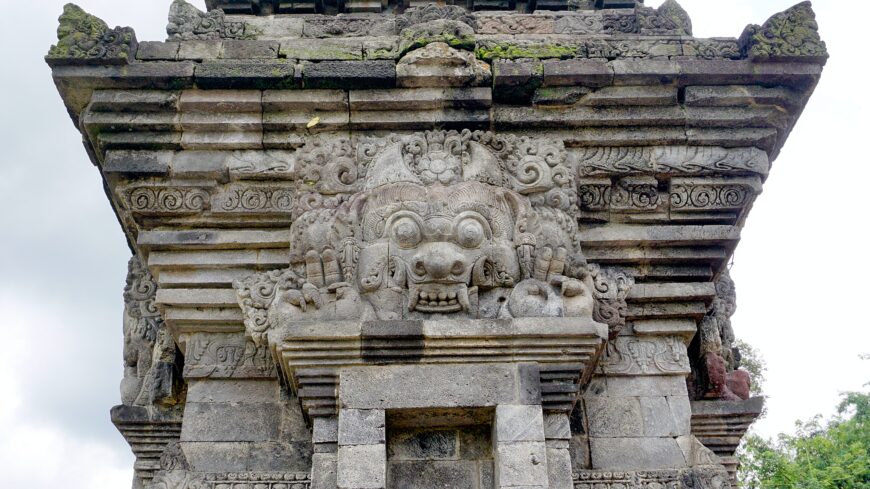
Kala, east side, Temple with Date at Penataran, 14th century, Java (photo: Anandajoti Bhikkhu, CC BY 2.0)
Kala figures also appear above niches on the other three sides of the Temple with Date. In all four images, Kala is depicted with bulging eyes, fangs, and horns. Kala appears in art bodiless, with the exception of its hands that are used to frame its face. Inside of the Temple with Date is a statue of Ganesha. It is unclear why Ganesha is presented as a central figure as this is unusual at ancient Javanese temples. It has been suggested that the statue may have once adorned one of the three niches, now empty, and was moved to the chamber at a later date.
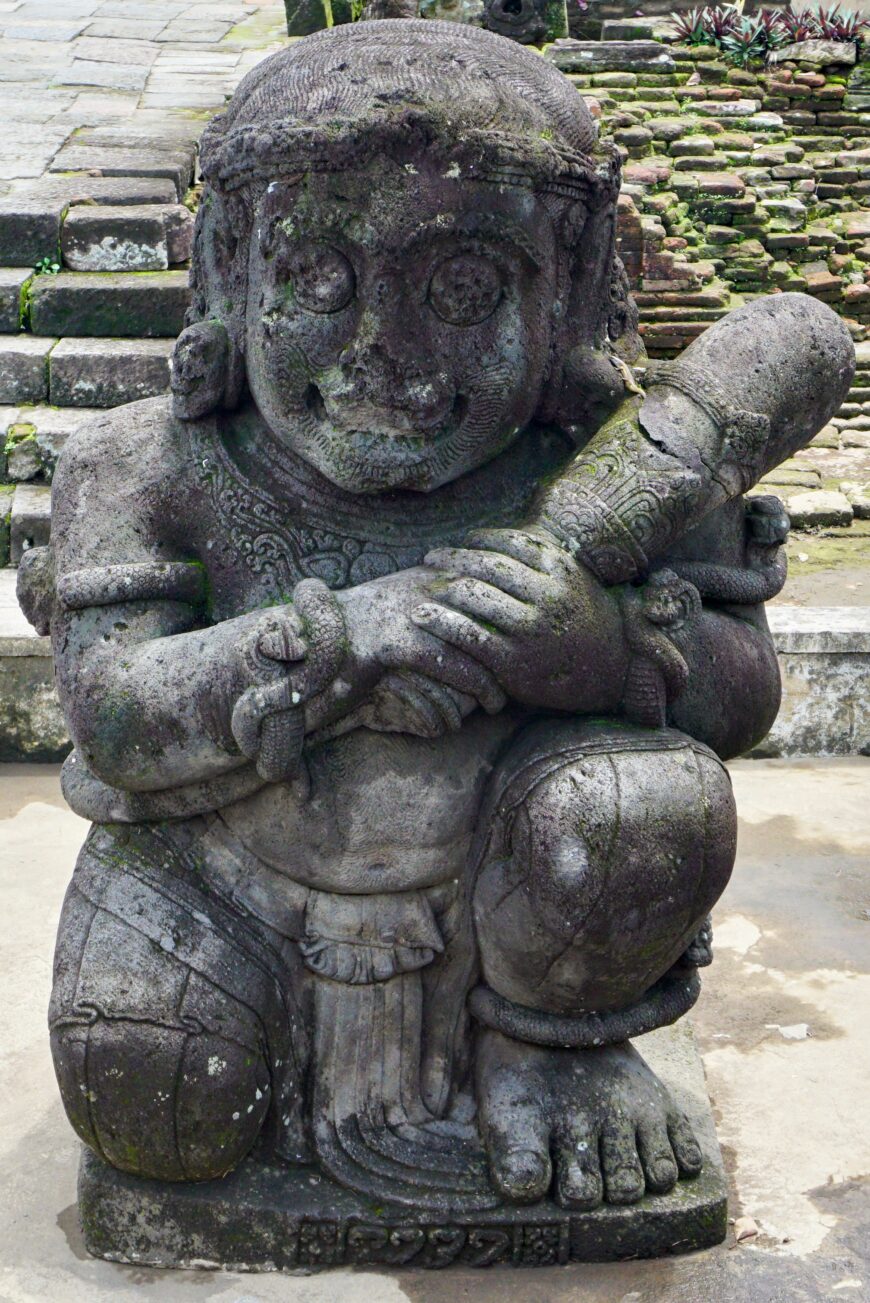
Guardian figure, second courtyard, Penataran, 14th century, Java (photo: Anandajoti Bhikkhu, CC BY 2.0)
Architectural layout: second courtyard
When you enter the second courtyard (located in the middle of the ground plan above), you are greeted by a pair of guardian statues shown in a squatting position with one knee on the ground. This is a posture of both obsequiousness and a readiness for action. They each hold a club that rests on the shoulder, typical of guardian figures from Java. The guardian figures are also adorned with necklaces and bracelets in the shapes of snakes.
The primary structure in the second courtyard is the Naga Temple (figure B on the plan) which gets its name from the large sculpted naga looping the upper body of the temple. This naga is being held aloft by nine richly adorned figures. It is not known whether these figures represent specific deities. At present, the temple has no roof, which may have originally been made of perishable materials. Also missing is the original statue that would have been housed inside. Apart from the Naga Temple, stone platforms indicate that there were other edifices within the second courtyard that are no longer extant.
Architectural layout: main courtyard
The Main Temple (figure A on the ground plan), located at the center of the main (or third) courtyard, is known for its carved reliefs of the Ramayana and Krishnayana stories. This temple is composed of three levels, with Ramayana reliefs on its first-level wall and Krishnayana on second-level. While the Ramayana series are read in a counter-clockwise direction, the Krishnayana story is arranged in a clockwise manner.
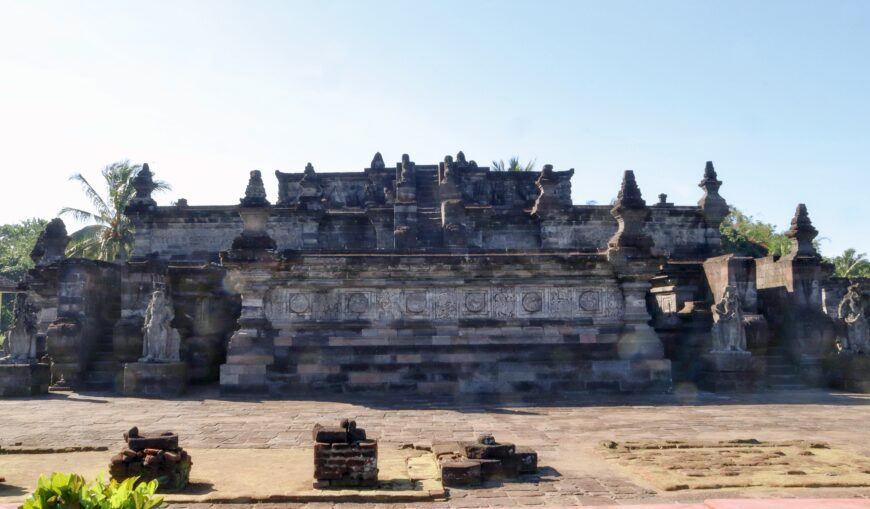
The Main Temple of Penataran, 12th–15th centuries, Java (photo: Panggah Ardiyansyah, CC BY-NC-SA 4.0)
The presentation of the Ramayana relief at the Main Temple is uncommon as it focuses on the figure of the monkey deity, Hanuman, instead of highlighting the central story of Ramayana involving the union of Rama and Sita. In particular, the panels depict the heroic efforts of Hanuman in assisting Rama to release Sita from Ravana who held her captive. On the south wall, one can see Hanuman conducting a reconnaissance mission into Ravana’s kingdom. After sneaking into the enemy’s palace, Hanuman is able to tell Sita about Rama’s plan to free her. This episode is immediately followed by the building of a dam with the help of the monkey army under the direction of Hanuman and his older brother Sugriwa. The final scene of the story illustrates the killing of the ogre commander, Kumbhakarna, by Hanuman.
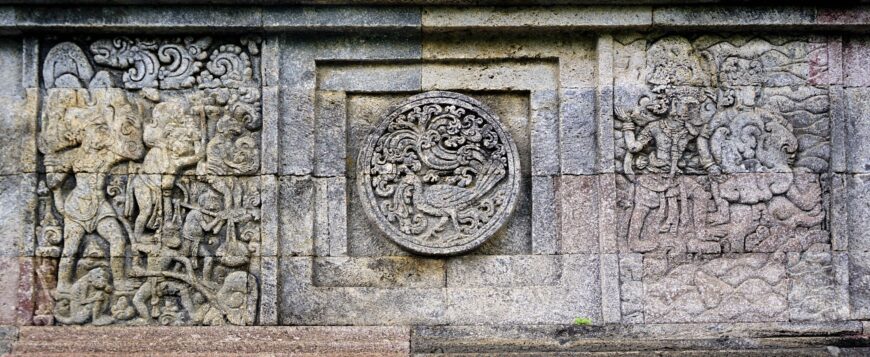
Two relief panels, flanking the medallion, showing the monkey army carrying huge stones on their shoulders to build a bridge on the left panel, while the right one depicting most likely Hanuman and Sugriwa, as the leaders of the monkey army, throwing massive stone blocks into the water, at Penataran, 14th century, Java (photo: Anandajoti Bhikkhu, CC BY 2.0)
Also depicted on the Main Temple are episodes from the Khrisnayana that outline the romantic story of Krishna and his wife, Rukmini. Initial panels of the reliefs depict the superhuman exploits of Krishna in defeating his enemies. However, the majority of the panels represent Krishna’s effort to rescue his future bride, Rukmini, from the hands of Suniti, King of Cedi. The ultimate battle scene at the Main Temple recounts the fighting between Krishna and Sukma’s armed warriors. Sukma, the brother of Rukmini, tried and failed to return Rukmini to King Suniti. His life is spared at Krishna’s mercy after passionate appeal by Rukmini. The final panel of the Khrisnayana story at Penataran depicts the couple living together in bliss.
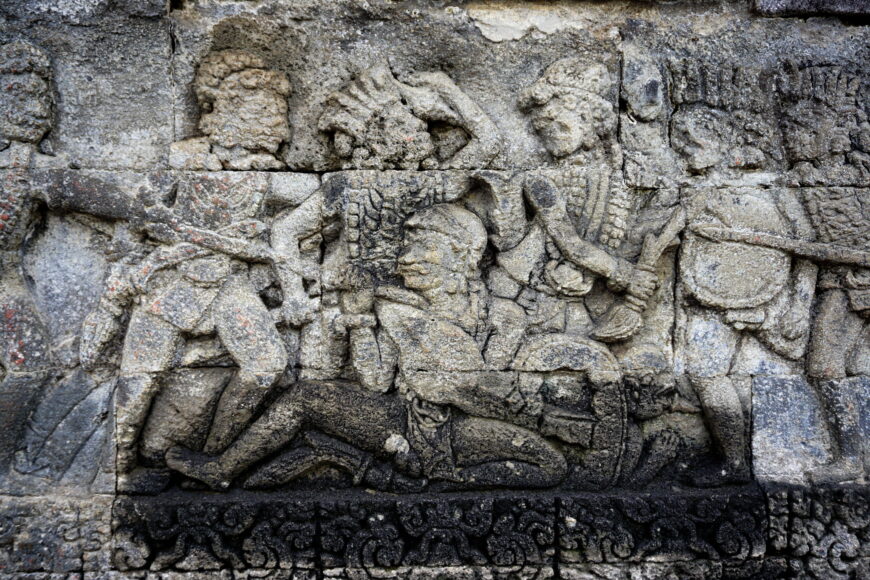
One of the fighting scenes taken from a long vertical relief panel showing the final battle scene in Krisnayana between Khrisna and Rukma (both are not shown in this image), whereby the foot soldiers wear round headbands not dissimilar to modern wayang (Javanese shadow puppet) characters, Penataran, 14th century, Java (photo: Anandajoti Bhikkhu, CC BY 2.0)
Three courtyards: symbolism of tripartite universe
In ancient Java, the universe was visualized as three separate realms, likely related to Hindu and Buddhist conceptions of their universes. For example, the 9th-century Buddhist temple Borobudur in central Java is symbolically divided into three vertical realms: kamadhatu (realm of worldly desires), rupadhatu (realm of form), and arupadhatu (realm of formlessness). Meanwhile, the structure of Hindu tower temples in Java are distinctly divided into three vertical realms: Bhurloka (realm of mortals), Bhuwarloka (realm of the purified) and Swarloka (realm of the gods). This comes from the understanding that gods reside on the summit of Mount Meru.
In this context, the layout of three courtyards at Penataran represents the visual manifestation of a tripartite universe. However, instead of visualizing the tripartite universe as a vertical ascent, at Penataran it is organized linearly moving towards Mount Kelud. In this way, Mount Kelud becomes the literal and symbolic summit of the Javanese gods. As the earthly abode to the gods, rulers of ancient Java sought to ensure that the deities would continue to live within their kingdoms by lavishing their patronage at the site of Penataran over the course of three centuries.
View east from the top of the main temple


